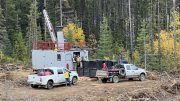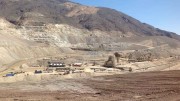There is no debating that Trelawney Mining and Exploration‘s (TRR-V) Côté Lake deposit is big. But the question on the minds of many junior gold investors is: Just how big?
The company has outlined 131 million tonnes grading 1 gram gold for 4.2 million oz. inferred resources, and it has done so in little more than a year after discovery.
But based on drilling performed outside of the estimate, analysts are convinced the number will soon grow by leaps and bounds.
Independent analysts estimate that the resource ranges from 8 million oz. to 10 million oz. Those numbers are based on drilling to-date.
The company plans to drill another 80,000 metres on well-defined targets, and it has consistently delivered stellar results from the drill bit. The ultimate size of the deposit is anyone’s guess.
The geological fun got underway for Trelawney with the discovery of Côté Lake in January 2010.
The discovery hole struck 1.16 grams gold over 136 metres, signalling the company was on to a deposit scale it had not previously seen at its Chester project. Chester is a property with three better known deposits, all of which have a different geological nature than Côté Lake.
The three deposits – Chester 1, Chester 2 and Chester 3 – host gold in quartz veins. Côté Lake hosts gold in disseminated sulphides.
While we stand in northern Ontario, halfway between Timmins and Sudbury, the Côté Lake deposit has Trelawney’s VP exploration David Beilhartz looking across the continent for comparables. Namely, at the porphyries of the Western Cordillera.
Roscoe Postle Associates arrived at a similar conclusion in its April 2011 technical report.
“Côté Lake is an unusual deposit type, which has characteristics suggestive of an Archean-aged porphyry gold deposit,” the report reads. “As such, it has the potential to become a large-tonnage, low-grade deposit amenable to open pit mining.”
Encountering a deposit of such scale presents its challenges – even if they are of the kind that gold juniors dream to contend with.
As the market clamours for results that will allow accurate valuation of the project, Beilhartz and his team of geologists struggle to keep up with an unending stream of core that is already flowing into its core shack.
“We’ve brought in some students for the summer to help log core. And now that they’re trained and up-to-speed, we’ve almost caught up with logging core from our winter program,” he says.
But while Beilhartz drives his team to stay on top of the core that has already accumulated, Trelawney’s president and chief executive Greg Gibson pushes for more.
“I could easily justify having 12 drills turning here,” Gibson says.
The comment elicits a chuckle from Beilhartz, who stands next to Gibson in the company’s core shack. The two must have come to terms at some other time, and at some other location.
Gibson tells the collection of analysts and brokers before him that the company has settled on eight rigs drilling between 80,000 and 90,000 metres for the year. This is an alteration of the company’s earlier vision, which would have seen 75,000 metres of drilling in the 2011 program.
Such a decision to ramp-up drilling has much to do with the market attention the company has drawn. With each significant set of drill results – and there have been many over the last year-and-a-half – Trelawney’s share price jumps ever higher.
Since announcing the initial discovery, Trelawney shares have climbed out of the 50¢-range and now trade at $4-5.
Gibson acknowledges a delicate balance between satisfying the yearnings of Bay Street, and doing what is feasible on the ground.
“There’s a broad line between exploration in the field and Bay Street,” he says.
“People in Toronto are watching us closely, but we’ve done this so quickly that we weren’t able to prepare for everything. But the world has said, ‘they’re on to the real deal’, so we have to keep on pushing.”
Management has thus far been up to the challenge. With nearly $100 million in the kitty, it has the financing to drive Côté Lake into one of Ontario’s, if not Canada’s, largest new discoveries.
Understanding how it will get there requires an understanding of where the company is in terms of exploration, and where it plans to go.
The deposit that has become a company maker for Trelawney was discovered while testing to see whether the mineralized body at Chester 2 extends westward to the other side of the Côté Lake.
Instead of an extension of Chester 2, Trelawney found something altogether different. It now compares the deposits to porphyries associated with low silica-to-alkali ratios, which is commonly referred to as the “diorite model.” Diorite model deposits have low sulfur mineralizing fluids, and not all the iron oxides are converted to pyrite. Much remains in chlorite and biotite.
Since releasing the initial resource estimate, Trelawney has marched the drills farther westward along fences that are 100 metres apart. Such drilling has, so far, defined a zone with a strike length of 1 km, beginning beneath Côté Lake itself and extending in a south-westerly direction.
As the drills head west, they continue to hit significant widths of mineralization.
The secret to the success of the program has much to do with geophysics. The deposit registers a strong induced polarization (IP) signal that doesn’t stop at the current deposit’s known boundary.
“The IP signature shows a zone extending southwest for another 300 metres (from the current deposit) before it heads directly south,” Gibson says, while standing in front of the geophysical maps laid out in the core shack. “And then there is a splay-off to the southeast as well, which we’ll have to get to at some point.”
“This system is so large that we’re not even seeing the big picture yet,” Beilhartz chimes in. “The alteration is different in the south than it is in the north.”
What the southern extensions hold in the eastern and western edges of the deposit won’t be known for some time. With every new fence of drilling, the deposit grows, further entrenching the idea that the company could be on to a 10-million-oz. deposit.
Jennings Capital mining analyst Peter Campbell believes the latest results show the company is headed precisely in that direction.
In a note issued on May 26 – the date of some of Trelawney’s most recent drill results – Campbell wrote that the results, which show mineralization continues farther west, have led him to raise his own non-compliant resource estimate.
“With mineralization now encountered on section 8600, we could potentially increase our mineral resource estimate beyond 9 million oz. at 1.13 grams per tonne gold,” Campbell wrote.
Jennings uses a traditional sectional polygon resource estimation method using sections released by Trelawney. It is a method that has proven successful. Campbell predicted that the initial resource estimate would come in at 4.6 million oz. – a number not far from the 4.2 million oz. that Trelawney reported.
The May results that increased Campbell’s projections were from four holes drilled to the west of the resource. One hole returned 170.2 metres grading 1.01 grams gold. The hole was a 300-metre step-out to the southwest of the known resource. Another hole returned 153 metres grading 1.64 grams gold.
More results issued on June 20 confirmed mineralization along the western fence, with one hole returning 173 metres grading 1.18 grams gold. The most impressive assay from the latest batch of results came from the same wetlands area that generated the initial resource, with hole E11-65
cutting 337 metres at 0.94 gram gold.
As for the official NI 43-101 resource update, Gibson is confident that many more ounces will be added, and says the update will be released late this year or early 2012.
Location, Location, Location
Like most significant discoveries, Chester sits in prime real estate for gold.
The property sits halfway between Timmins and Sudbury. Geologically, it is situated at the southeastern tip of the Swayze Archean greenstone belt.
The area is a southwestern extension of the Abitibi greenstone belt, which runs 50 km northeast of the property. The company says that a Proterozoic cover of sediments may mask a link to the Abitibi belt.
As for faults closer to home, the project lies just to the south of a major regional fault which appears to be a southwestern extension of the Cadillac-Larder Lake fault zone.
Such rich geology has blessed Trelawney with a bounty of gold options.
But as compelling as Côté Lake is, it does not represent the complete Trelawney story.
The company belongs to two stories: the story of Côté Lake, and the story of the Chesters. Chesters is a collection of deposits that first drew Trelawney to the property, and have already produced gold.
Combined, the three Chesters have historical measured and indicated resources of 1.6 million tonnes grading 8.9 grams gold for 467,000 oz. gold. Those numbers were enticing enough to encourage development of Chester 1 into an underground mine.
Trelawney put development on hold, however, to focus on Côté Lake and the nature of gold mineralization at Chester 1. Mineralization at Chester 1 is erratic. Rather than tracking a continuous vein, it pinches out and begins again in another area.
“We can get 300 grams, 600 grams and 25 grams for 35 feet, and then we get nothing. And then it will hit again,” Gibson explains. “The problem is, we’re losing it on strike and vertically as well. So we end up diluting a lot of the tonnage.”
The company plans to continue underground drilling, with the aim of getting a better handle on the controls of the deposit that has a 4.5-km strike length.
Next steps
While it is early in the evolution of Côté Lake, a company doesn’t make a discovery of this nature without keeping a cold eye on development and permitting issues.
Trelawney has signed a $2.5- million contract with AMEC to move the permit process in the right direction.
A future open pit would divert the Molly River, which runs through the heart of the deposit.
“We’re in Canada,” Gibson says. “So anything can get done. But you have to go through the bureaucracy to get it done. There’s a process, and we’ll follow that process.”
Mining for gold in northern Ontario also means communicating with the First Nations.
Gibson says the company enjoys good relations with the Mattagami First Nations, who have called the land home for many generations. Those good relations are evidenced by the exploration agreement signed between the two parties in September 2009.
One new challenge on the horizon could, however, come from Flying Post First Nation, which has recently voiced a claim on the land.
Gibson, however, is confident that the matter will be quickly resolved.
“First Nations issues are just a cost of doing business,” Gibson says. “There’s no problem with it. It just has to be put into your costs.”






Be the first to comment on "Ct Lake: How big can it get?"